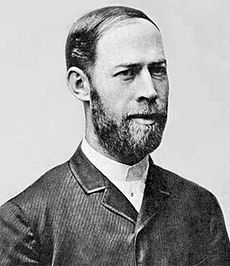ហេនរីច ហឺត៖ ភាពខុសគ្នារវាងកំណែនានា
ខ្លឹមសារដែលបានលុបចោល ខ្លឹមសារដែលបានសរសេរបន្ថែម
WIP - |
(គ្មានភាពខុសគ្នា)
|
កំណែនៅ ម៉ោង០៦:៣១ ថ្ងៃពុធ ទី២២ ខែកុម្ភៈ ឆ្នាំ២០១២
Heinrich Rudolf Hertz (February 22, 1857 – January 1, 1894) was a German physicist who clarified and expanded the electromagnetic theory of light that had been put forth by Maxwell. He was the first to conclusively prove[១] the existence of electromagnetic waves by engineering instruments to transmit and receive radio pulses using experimental procedures that ruled out all other known wireless phenomena.
- ↑ Prof. D. E. Hughes' Research in Wireless Telegraphy, The Electrician, Volume 43, 1899, pages 35, 40-41, 93, 143-144, 167, 217, 401, 403, 767. Elihu Thomson recognized the Hughes claim to be the first to transmit radio. Hughes himself said "with characteristic modesty" that Hertz's experiments were "far more conclusive than mine", and that Marconi's "efforts at demonstration merit the success he has received...[and] the world will be right in placing his name on the highest pinnacle, in relation to aerial electric telegraphy".
| Heinrich Rudolf Hertz | |
|---|---|
 | |
| កើតនៅ | February 22, 1857 Hamburg, German Confederation |
| មរណភាព | January 1, 1894 (អាយុ 36 ឆ្នាំ) Bonn, German Empire |
| Residence | Germany |
| សញ្ជាតិ | German |
| ឯកទេស | Physics Electronic Engineering |
| Institutions | University of Kiel University of Karlsruhe University of Bonn |
| Alma mater | University of Munich University of Berlin |
| Doctoral advisor | Hermann von Helmholtz |
| Known for | Electromagnetic radiation Photoelectric effect |
Signature | |